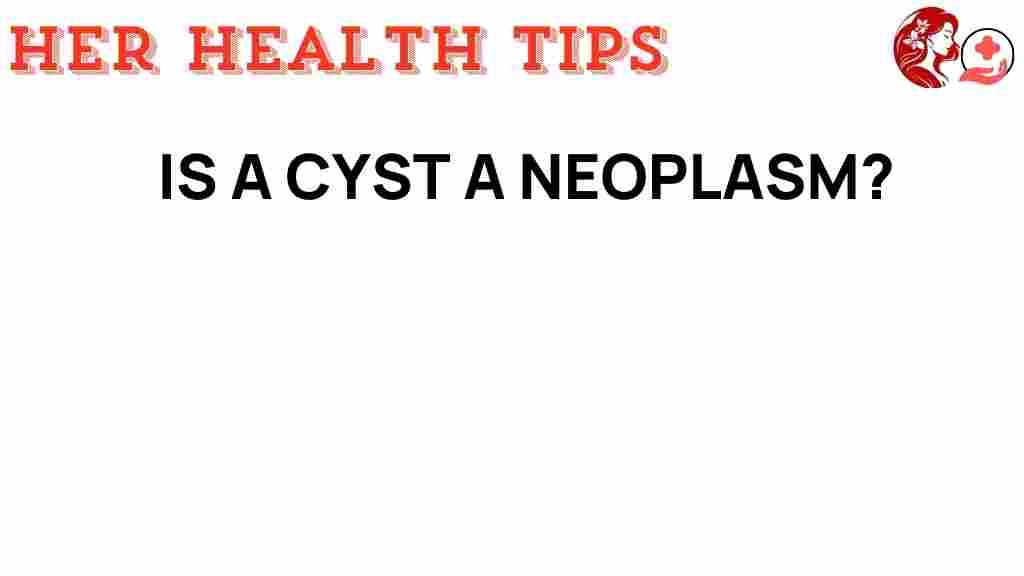Unraveling the Mystery: Is a Cyst Truly a Neoplasm?
In the realm of health and diagnosis, the terms “cyst” and “neoplasm” often create confusion. While both refer to abnormal growths in the body, they are not synonymous. Understanding the differences between these two entities is crucial for accurate medical terminology and effective pathology. This article aims to clarify the definitions, symptoms, treatment options, and implications of cysts and neoplasms.
The Basics: What is a Cyst?
A cyst is a closed sac-like structure that can be filled with fluid, semi-solid material, or gas. Cysts can form in various parts of the body, including the skin, organs, and tissues. They are usually benign and can vary in size from tiny to several centimeters in diameter.
Common Types of Cysts
- Dermoid Cysts: Typically found on the skin, these cysts can contain hair, skin, and even teeth.
- Ovarian Cysts: Common among women, these cysts form on the ovaries and can cause pain or irregular menstrual cycles.
- Baker’s Cyst: A fluid-filled sac behind the knee that can cause swelling and discomfort.
- Pilomatricoma: A benign skin tumor that often appears as a cyst.
While most cysts are harmless, some may cause discomfort or indicate underlying health issues, necessitating further investigation.
Understanding Neoplasms
On the other hand, a neoplasm is a term used to describe an abnormal growth of tissue that can be benign or malignant. Neoplasms are commonly referred to as tumors. Unlike cysts, neoplasms arise from uncontrolled cell division, which can lead to cancerous growths.
Types of Neoplasms
- Benign Neoplasms: Non-cancerous tumors that do not invade nearby tissues or spread to other parts of the body.
- Malignant Neoplasms: Cancerous tumors that can invade surrounding tissues and metastasize to distant organs.
Recognizing the type of neoplasm is vital for determining the appropriate treatment and prognosis.
Key Differences Between Cysts and Neoplasms
While both cysts and neoplasms are abnormal growths, several key differences set them apart:
- Composition: Cysts are fluid-filled sacs, while neoplasms consist of abnormal tissue.
- Growth Behavior: Cysts typically grow slowly and remain localized, whereas neoplasms can be aggressive and spread.
- Diagnosis: Cysts are often diagnosed through imaging tests, while neoplasms may require biopsies for accurate diagnosis.
Symptoms: When to Seek Medical Attention
Both cysts and neoplasms can present symptoms that should not be ignored. Here are some common symptoms associated with each:
Symptoms of Cysts
- Swelling or lump in the affected area
- Pain or tenderness
- Skin changes, such as redness or warmth
- Discharge of fluid if the cyst ruptures
Symptoms of Neoplasms
- Unexplained weight loss
- Persistent pain or discomfort
- Changes in bowel or bladder habits
- Fatigue and weakness
- Visible lumps or masses
If you experience any of these symptoms, it is essential to consult a healthcare professional for a proper evaluation and diagnosis.
Diagnosis: How are Cysts and Neoplasms Identified?
The diagnostic process for cysts and neoplasms often involves several steps:
Step-by-Step Diagnostic Process
- Medical History: The physician will take a thorough medical history and inquire about symptoms.
- Physical Examination: A physical exam may reveal the presence of a lump or discomfort.
- Imaging Tests: Techniques such as ultrasounds, CT scans, or MRIs can help visualize the growth.
- Biopsy: For neoplasms, a tissue sample may be taken to determine if the growth is benign or malignant.
Proper diagnosis is crucial for determining the right course of treatment.
Treatment Options for Cysts and Neoplasms
The treatment for cysts and neoplasms varies significantly based on their nature. Here’s a breakdown of typical treatment approaches:
Treatment for Cysts
- Observation: Many cysts do not require treatment unless they cause discomfort.
- Drainage: A healthcare professional may drain the cyst if it is painful or infected.
- Surgery: In some cases, surgical removal of the cyst may be necessary.
Treatment for Neoplasms
- Surgery: Removal of the tumor is often the first line of treatment.
- Radiation Therapy: This can be used to kill cancer cells or shrink tumors.
- Chemotherapy: Systemic treatment to kill or slow the growth of cancer cells.
- Targeted Therapy: Specific treatments aimed at particular characteristics of the tumor.
Choosing the right treatment approach depends on the type, size, and location of the growth, as well as the overall health of the patient.
Conclusion: Understanding the Distinction
In summary, while both cysts and neoplasms are abnormal growths, they differ significantly in their composition, behavior, and implications for health. Cysts are generally benign and may not require treatment, whereas neoplasms can be serious and may necessitate aggressive intervention.
Understanding these differences can empower individuals to seek timely medical advice and intervention. If you suspect you have a cyst or neoplasm, don’t hesitate to consult with a healthcare provider for an accurate diagnosis and appropriate treatment options.
For more information on medical terminology and health conditions, feel free to explore this informative resource.
As you navigate your health journey, remember that knowledge is power. Stay informed about your body and never hesitate to reach out for professional guidance.
This article is in the category Conditions and created by HerHealthTips Team
